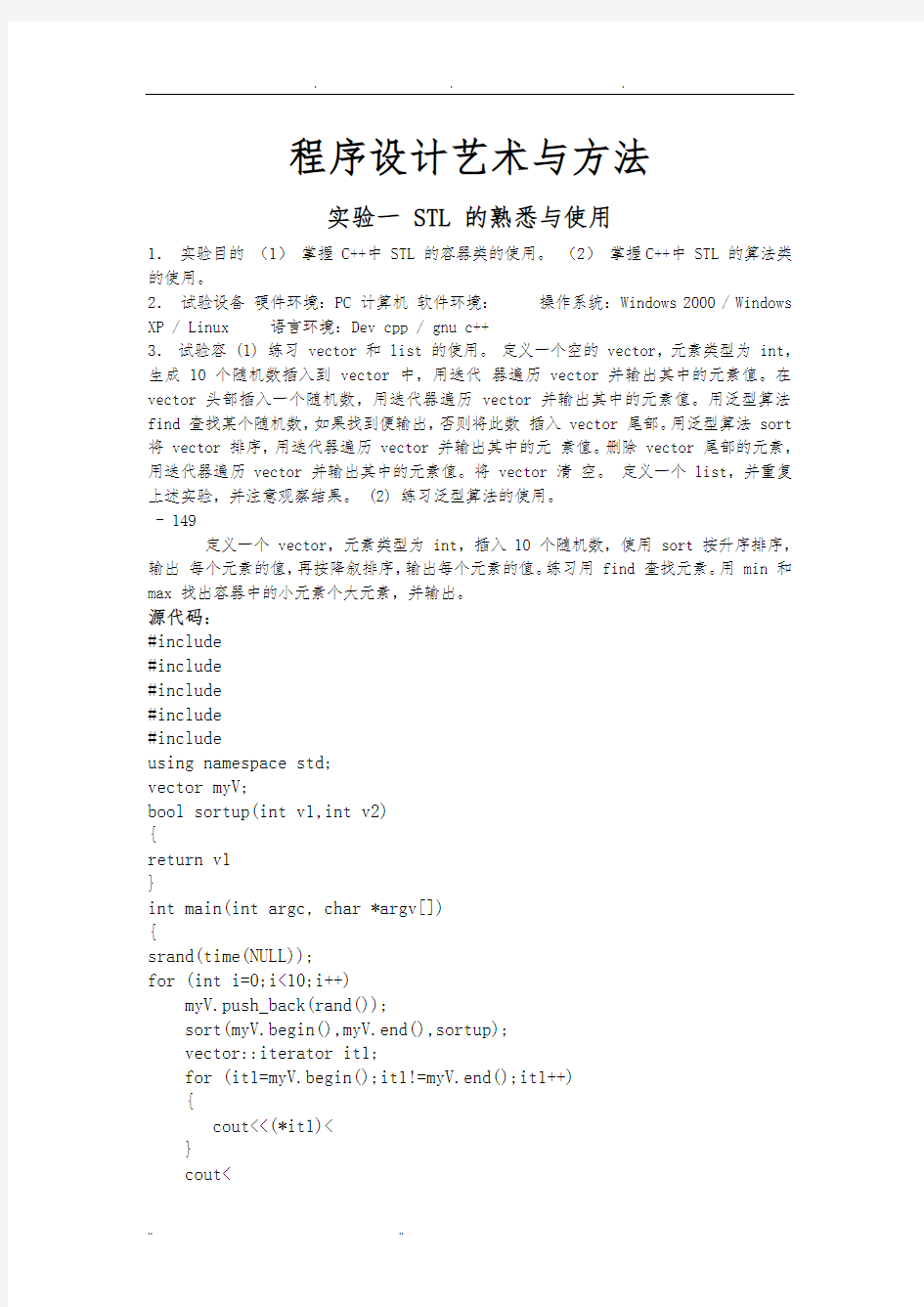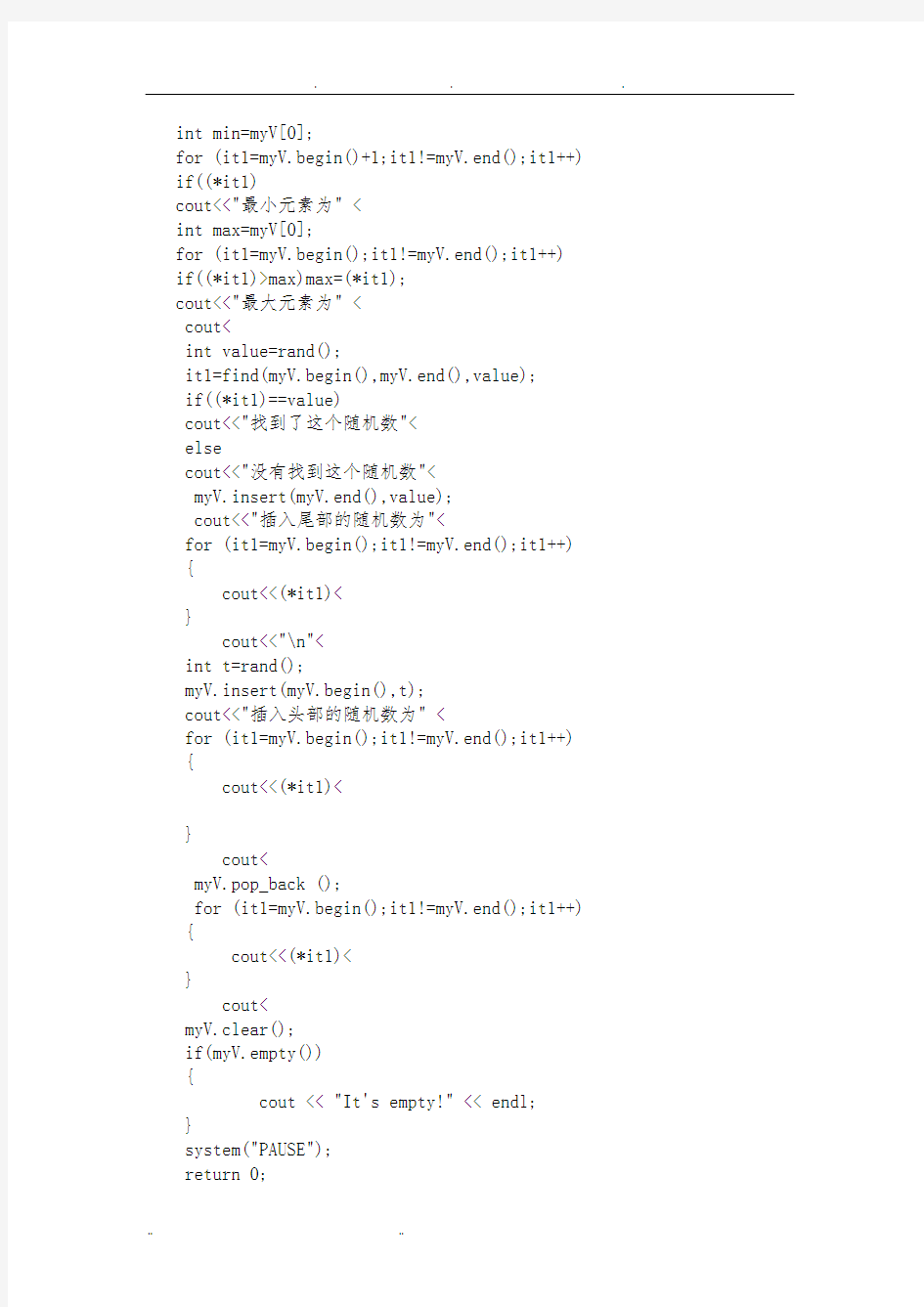

程序设计艺术与方法
实验一 STL 的熟悉与使用
1.实验目的(1)掌握 C++中 STL 的容器类的使用。(2)掌握C++中 STL 的算法类的使用。
2.试验设备硬件环境:PC 计算机软件环境:操作系统:Windows 2000 / Windows XP / Linux 语言环境:Dev cpp / gnu c++
3.试验容 (1) 练习 vector 和 list 的使用。定义一个空的 vector,元素类型为 int,生成 10 个随机数插入到 vector 中,用迭代器遍历 vector 并输出其中的元素值。在vector 头部插入一个随机数,用迭代器遍历 vector 并输出其中的元素值。用泛型算法find 查找某个随机数,如果找到便输出,否则将此数插入 vector 尾部。用泛型算法 sort 将 vector 排序,用迭代器遍历 vector 并输出其中的元素值。删除 vector 尾部的元素,用迭代器遍历 vector 并输出其中的元素值。将 vector 清空。定义一个 list,并重复上述实验,并注意观察结果。 (2) 练习泛型算法的使用。
- 149
定义一个 vector,元素类型为 int,插入 10 个随机数,使用 sort 按升序排序,输出每个元素的值,再按降叙排序,输出每个元素的值。练习用 find 查找元素。用 min 和max 找出容器中的小元素个大元素,并输出。
源代码:
#include
#include
#include
#include
#include
using namespace std;
vector
bool sortup(int v1,int v2)
{
return v1 } int main(int argc, char *argv[]) { srand(time(NULL)); for (int i=0;i<10;i++) myV.push_back(rand()); sort(myV.begin(),myV.end(),sortup); vector for (it1=myV.begin();it1!=myV.end();it1++) { cout<<(*it1)< } cout< int min=myV[0]; for (it1=myV.begin()+1;it1!=myV.end();it1++) if((*it1) cout<<"最小元素为" < int max=myV[0]; for (it1=myV.begin();it1!=myV.end();it1++) if((*it1)>max)max=(*it1); cout<<"最大元素为" < cout< int value=rand(); it1=find(myV.begin(),myV.end(),value); if((*it1)==value) cout<<"找到了这个随机数"< else cout<<"没有找到这个随机数"< myV.insert(myV.end(),value); cout<<"插入尾部的随机数为"< cout<<(*it1)< } cout<<"\n"< int t=rand(); myV.insert(myV.begin(),t); cout<<"插入头部的随机数为" < for (it1=myV.begin();it1!=myV.end();it1++) { cout<<(*it1)< } cout< myV.pop_back (); for (it1=myV.begin();it1!=myV.end();it1++) { cout<<(*it1)< } cout< myV.clear(); if(myV.empty()) { cout << "It's empty!" << endl; } system("PAUSE"); return 0; } 运行截图: 2 练习泛型算法的使用: 源代码: #include #include //#inclued using namespace std; typedef list int value[]={1,2,3,4,5}; void print(lin &l) { int i; lin::iterator lit; for(lit=l.begin();lit!=l.end();lit++) cout<<(*lit)<<" "; cout< } bool sortsp(int v1,int v2) { return v1>v2; } int main(){ lin lin2; lin2.push_front(3); lin2.push_front(4); lin2.insert(lin2.begin(),value,value+5); cout<<"lin2的元素为:"; print(lin2); lin2.sort(); cout<<"排序后的lin2: "; print(lin2); lin2.push_front(10); cout<<"在list头部插入10之后的结果:"; print(lin2); lin2.remove(6); cout<<"删除一个数后的lin1:"; print(lin2); system("PAUSE"); return 0; } 运行截图: 实验二搜索算法的实现 1. 实验目的 (1) 掌握宽度优先搜索算法。 (2) 掌握深度优先搜索算法。 2. 试验设备硬件环境:PC 计算机软件环境:操作系统:Windows 2000 / Windows XP / Linux 语言环境:Dev cpp / gnu c++ 3. 试验容 (1) 将书上的走迷宫代码上机运行并检验结果,并注意体会搜索的思想。 (2) 八皇后问题:在一个国际象棋棋盘上放八个皇后,使得任何两个皇后之间不相互攻击,求出所有的布棋方法。上机运行并检验结果。思考:将 此题推广到 N 皇后的情况,检验在 N 比较大的情况下,比方说 N=16 的时候,你的程序能否快速的求出结果,如果不能,思考有什么方法能够优化算法。 (3) 骑士游历问题:在国际棋盘上使一个骑士遍历所有的格子一遍且仅一遍,对于任意给定的顶点,输出一条符合上述要求的路径。 (4) 倒水问题:给定 2 个没有刻度容器,对于任意给定的容积,求出如何只用两个瓶装出 L 升的水,如果可以,输出步骤,如果不可以,请输出 No Solution。 (2)八皇后问题 源代码: #include using namespace std; #include int sum = 0; int upperlimit = 1; void compare(int row,int ld,int rd) { if(row!=upperlimit) { int pos=upperlimit&~(row|ld|rd); while(pos!=0) { int p=pos&-pos;pos-=p; compare(row+p,(ld+p)<<1,(rd+p)>>1); } } else{sum++; } } int main() { int n; cout<<"请输入皇后的个数:"; cin>>n; upperlimit = (upperlimit< compare(0,0,0); cout<<"问题的解如下:"< return 0; } 运行截图: (4)倒水问题 源代码: 4.倒水问题: #include"stdio.h" int main() { int ca,cb,cc,x,y; while(scanf("%d%d%d",&ca,&cb,&cc)!=EOF) { if(cb==cc) { printf("fill B\n"); } else if(ca==cc) { printf("fill A\n"); printf("pour A B\n"); } else { x=y=0; if(ca { while(1) { if(y==0)